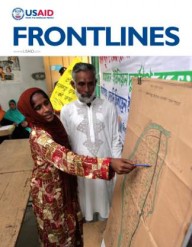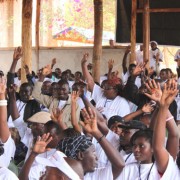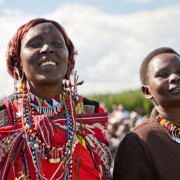 Catherine “Chiku” Wanjiku, a news editor and on-air journalist for the community radio station Loch FM in Korogocho, Nairobi, was trained through a USAID program implemented by Internews.
Christian Viseux, Internews
Catherine “Chiku” Wanjiku, a news editor and on-air journalist for the community radio station Loch FM in Korogocho, Nairobi, was trained through a USAID program implemented by Internews.
Christian Viseux, Internews
 Catherine “Chiku” Wanjiku, a news editor and on-air journalist for the community radio station Loch FM in Korogocho, Nairobi, was trained through a USAID program implemented by Internews.
Christian Viseux, Internews
Catherine “Chiku” Wanjiku, a news editor and on-air journalist for the community radio station Loch FM in Korogocho, Nairobi, was trained through a USAID program implemented by Internews.
Christian Viseux, Internews
In 2003, a staggering 700 people were dying every day in Kenya as a result of HIV complications. AIDS was a disease of crisis proportions, still characterized at the time by secrecy, fear, rumor, myth and misleading information.
That same year, USAID, with partner Internews, launched a health journalism program in Kenya with the aim of creating a more supportive social environment to prevent and mitigate the impact of HIV/AIDS through more informed media coverage.
“[At first] the media houses were not willing to talk about it. It did not make the headlines. But since then, there has been a big shift right up to the senior level,” said Sammy Muraya, who was trained by the program and now works as a media consultant. “[The program] was part of making that shift possible. The biggest fight was killing stigma. And this had to start with the journalists themselves. Not with the public. But with the media.”
This past year, Internews conducted an assessment of its work in Kenya that found that the media are a key factor in improving the lives of Kenyans by providing more, better and deeper coverage of complex health issues that matter to them.
The impact assessment A Story a Day... The Media as a Preventive Tool in Public Health included survey data showing that 87 percent of respondents found health news “very important,” and 90 percent said they found news stories more useful and compelling than public service announcements. At the same time, three-quarters of journalists said USAID-backed seminars were more useful than their diploma courses, and 88 percent said they had more stories published as a result of the trainings.
“While many factors have helped slow down the spread of HIV/AIDS, including access to antiretroviral drugs through PEPFAR, prevention and educational efforts through public awareness programs have played a significant role,” said David Stanton, director of the Office of HIV/AIDS at USAID, one of the lead implementers of the PEPFAR program globally.
In 1990, 14 percent of Kenyans between 15 and 64 years old were HIV-positive. In 2009, that figure was down to just over 6 percent.
“For the media, statistics and data are important in telling a complex human story with its public health and socio-economic consequences,” said Ida Jooste, Internews Kenya country director. “HIV was, and still is, a global disease like no other in living memory. It cast a very long shadow over the media.”
A Media History
From the moment it first surfaced in the early 1980s as a mystery illness with no identifiable cause, HIV/AIDS gave rise to ugly rumors and misleading speculation, and challenged journalists as they struggled to write about it. Many in the media simply chose to ignore it. Those who did report on the stealthy disease had to make sense of the associated stigma and discrimination, and in many instances failed the test. Stories were sensationalized, adding to the horror and indignity that followed those who fell ill.
Kenya was not spared. Like their peers around the world, Kenyan journalists struggled to tell the story of this complex, often confusing and constantly changing disease, even as the media landscape in the country itself was undergoing a rapid democratic evolution.
“We were just dumping information,” said broadcast and health journalist Sandra Ndonye, a former talk show host for KBC Radio and TV, and founder of Speak Up Media, a private media consultancy firm. “[The health journalism program] helped us to write more meaningfully about HIV and understand how to show its real face.”
Although at a policy level, a National AIDS Committee was established in 1985, followed by the National AIDS/STD Control Program, little was happening in terms of implementation.
This changed when former President Daniel Arap Moi in 1999 declared the AIDS epidemic a national disaster and established the National AIDS Control Council. However, it would take several years, beyond 2003, before any real public health progress was seen in terms of stemming the tide.
The USAID-funded media project, first known as Local Voices, and later as Voices in Health, set out to create a more supportive social environment for preventing and mitigating the impact of AIDS by working with the media to ensure better quality coverage of HIV and other health concerns.
“Over the years, we’ve really been able to see significant gains in the coverage of HIV,” Jooste said. “A decade ago, only two journalists in Kenya were known to write regularly about HIV/AIDS.”
Yet because of trainings, seminars and direct engagement with media outlets, more than 900 journalists have learned to report responsibly on the HIV epidemic to date. Internews records show that at least 1,287 stories are directly attributable to support from USAID journalism-training activities.
According to Deborah Ensor, Internews vice president for Africa, the journalism health program’s objectives were twofold. “We really wanted to secure the commitment of news media managers and owners in the response to HIV and AIDS, while strengthening the skills of journalists and providing them with on-going resources to expand and improve their reporting,” she said.
The program armed journalists and talk show hosts with the knowledge and vocabulary to include constructive and accurate messages about HIV and AIDS in their programs to counteract confusion, tackle denial and stigma associated with the disease, and increase dialogue with experts and public officials.
Regina Ombam, head of strategy for Kenya’s National AIDS Control Council in the Office of the President, tackles the role of the media head-on. “Principally, I look at journalism in the health sector as a very strong preventive method to use a cost effective way to deal with health. Once people know about their health, they will take responsibility for it. This will save the country much more than if we let people get diseases and then treat them,” she said.
Evolving Disease, Evolving Reporting
As HIV evolved, so too did training to encompass the corresponding policy change. Starting in 2009, the program expanded its health journalism focus to include mother and child health, family planning and reproductive health—recognizing that communities in Kenya often grapple with all these health issues simultaneously.
“By the end of PEPFAR I, we realized that to increase the pace of progress and save lives, we needed to scale up faster and smarter and move beyond just direct support of anti-AIDS drugs. We needed to understand the complexities of the disease and examine the problem from every single angle,” said Robert Clay, deputy assistant administrator in USAID’s Global Health Bureau and former director of the Office of HIV/AIDS.
“As this shift began to occur, it became imperative that journalists on the ground—who were reporting on the epidemic and on the front lines of educating the public—really understand what all the pieces meant and how the puzzle came together. This public health panorama was like no other.”
One of the most recent initiatives has been to educate Kenyan journalists—who are then educating their fellow citizens through the media—on voluntary medical male circumcision to reduce the spread of HIV. It’s a good-news story that shows how Kenya is leading the way in dealing with the disease, and putting Kenyan scientists and health advocates in the world’s limelight in the process.
“This training was for me an ‘aha’ moment,” said journalist Ernest Waititu, founder/editor of Afrikanews.org and former freelance contributor for The Nation, who participated in a three-week photography workshop on voluntary medical male circumcision. “When I started the training […], something was let loose from within me. … We were here on the islands of Lake Victoria to document the story of a community that was taking baby steps into voluntary male circumcision.”
With support from donors, the country performed more than 350,000 procedures by the end of 2011, making Kenya one of the top adopters in East and Southern Africa.
The outward success of such programs points to a major attitudinal shift inside Kenya’s newsrooms. “When Internews started its work in Kenya in 2003, there was no newsroom culture to support journalists who wanted to focus on public health, and none were encouraged to specialize in health reporting,” said Internews’ Jooste. “Today, numerous media houses boast a dedicated health slot—proof of the commitment of media managers and owners to respond to HIV and AIDS.”
“I think there’s been a lot of impact,” said Dr. Joseph Sitienei of the National AIDS & STI Control Program, which helps with journalist training. “Now we see much more health-related activities translated into articles and electronic media.”
Hungry for Information
Kenyans are clamoring for more information on health. A 2012 Internews survey found that 60 percent of respondents said they had no information on heart disease, and around half had no information on cancer and diabetes. When asked to rank the top three health topics they would like more information on, survey respondents most often ranked HIV as remaining among the top three at 42 percent.
“We have dedicated sports reporters who know the rules of the game and the names of the players, but if we randomly assign reporters to cover health, then the public and health services get a raw deal,” says Dr. Maurice Siminyu, the Coast region provincial director of medical services.
Reporters and editors who have participated in the journalism program attribute their career growth to their exposure to the ongoing training and mentoring.
“Some of the best health stories published and broadcast over the last two years have been by reporters trained by Internews and given grants to file the untold stories in remote parts of the country,” said Denis Galava, managing editor of the Saturday Nation. “As an experienced journalist, I know there are many stories we don’t report largely because they are not part of the daily slipstream that ‘moves papers’ on the stands (like politics); or the news desk lacks the capacity, resources and patience to piece the bits together into a narrative. I see this knowledge- and resources-gap being filled by [this program] that helps journalists tell the stories that directly affect the people, and help improve their living standards.”
Vitalis Musebe, editor-in-chief of Kenya Broadcasting Corporation, says the health journalism program has given journalists the opportunity to travel to remote parts of the country to tell the untold stories and helped to transform lives. “Most of the [trained] journalists … tend to exhibit unequaled energy, commitment and passion in reporting health issues.”
- In-depth journalism training provided hands-on, practical lessons that resulted in stories packaged for broadcast or written for print outlets. This entailed close mentoring by trainers.
- In-newsroom mentoring helped to create trust between local journalists and editors and program staffers.
- A Media Resource Center gave journalists access to state-of-the-art production facilities to help them package their broadcast stories. It also served as a place where journalists could mingle and learn from one another.
- Travel grants allowed journalists to report from different parts of the country.
- Roundtables gave reporters a chance to meet experts in health-related fields.
- News editors and media owners, crucial links in the editorial chain, worked with reporters to ensure they had the support they needed to cover the story.
- NGO engagement encouraged storytelling from other stakeholders in the health sector.












Comment
Make a general inquiry or suggest an improvement.